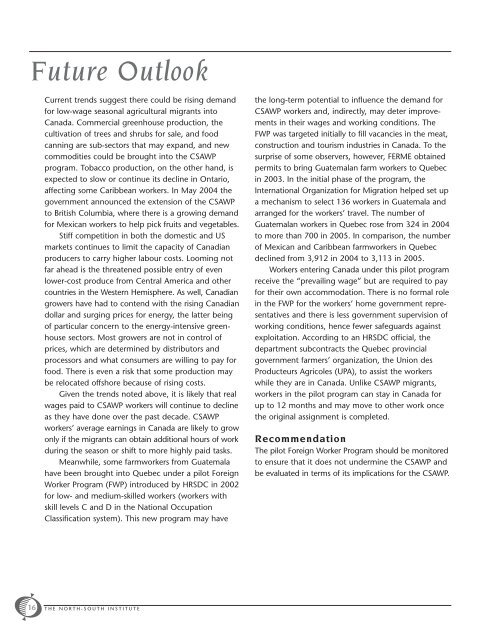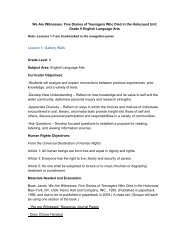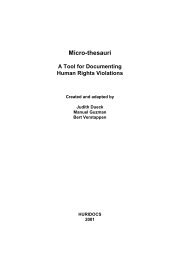Migrant Workers Canada
Migrant Workers in Canada - The North-South Institute
Migrant Workers in Canada - The North-South Institute
- No tags were found...
You also want an ePaper? Increase the reach of your titles
YUMPU automatically turns print PDFs into web optimized ePapers that Google loves.
Future Outlook<br />
Current trends suggest there could be rising demand<br />
for low-wage seasonal agricultural migrants into<br />
<strong>Canada</strong>. Commercial greenhouse production, the<br />
cultivation of trees and shrubs for sale, and food<br />
canning are sub-sectors that may expand, and new<br />
commodities could be brought into the CSAWP<br />
program. Tobacco production, on the other hand, is<br />
expected to slow or continue its decline in Ontario,<br />
affecting some Caribbean workers. In May 2004 the<br />
government announced the extension of the CSAWP<br />
to British Columbia, where there is a growing demand<br />
for Mexican workers to help pick fruits and vegetables.<br />
Stiff competition in both the domestic and US<br />
markets continues to limit the capacity of Canadian<br />
producers to carry higher labour costs. Looming not<br />
far ahead is the threatened possible entry of even<br />
lower-cost produce from Central America and other<br />
countries in the Western Hemisphere. As well, Canadian<br />
growers have had to contend with the rising Canadian<br />
dollar and surging prices for energy, the latter being<br />
of particular concern to the energy-intensive greenhouse<br />
sectors. Most growers are not in control of<br />
prices, which are determined by distributors and<br />
processors and what consumers are willing to pay for<br />
food. There is even a risk that some production may<br />
be relocated offshore because of rising costs.<br />
Given the trends noted above, it is likely that real<br />
wages paid to CSAWP workers will continue to decline<br />
as they have done over the past decade. CSAWP<br />
workers’ average earnings in <strong>Canada</strong> are likely to grow<br />
only if the migrants can obtain additional hours of work<br />
during the season or shift to more highly paid tasks.<br />
Meanwhile, some farmworkers from Guatemala<br />
have been brought into Quebec under a pilot Foreign<br />
Worker Program (FWP) introduced by HRSDC in 2002<br />
for low- and medium-skilled workers (workers with<br />
skill levels C and D in the National Occupation<br />
Classification system). This new program may have<br />
the long-term potential to influence the demand for<br />
CSAWP workers and, indirectly, may deter improvements<br />
in their wages and working conditions. The<br />
FWP was targeted initially to fill vacancies in the meat,<br />
construction and tourism industries in <strong>Canada</strong>. To the<br />
surprise of some observers, however, FERME obtained<br />
permits to bring Guatemalan farm workers to Quebec<br />
in 2003. In the initial phase of the program, the<br />
International Organization for Migration helped set up<br />
a mechanism to select 136 workers in Guatemala and<br />
arranged for the workers’ travel. The number of<br />
Guatemalan workers in Quebec rose from 324 in 2004<br />
to more than 700 in 2005. In comparison, the number<br />
of Mexican and Caribbean farmworkers in Quebec<br />
declined from 3,912 in 2004 to 3,113 in 2005.<br />
<strong>Workers</strong> entering <strong>Canada</strong> under this pilot program<br />
receive the “prevailing wage” but are required to pay<br />
for their own accommodation. There is no formal role<br />
in the FWP for the workers’ home government representatives<br />
and there is less government supervision of<br />
working conditions, hence fewer safeguards against<br />
exploitation. According to an HRSDC official, the<br />
department subcontracts the Quebec provincial<br />
government farmers’ organization, the Union des<br />
Producteurs Agricoles (UPA), to assist the workers<br />
while they are in <strong>Canada</strong>. Unlike CSAWP migrants,<br />
workers in the pilot program can stay in <strong>Canada</strong> for<br />
up to 12 months and may move to other work once<br />
the original assignment is completed.<br />
Recommendation<br />
The pilot Foreign Worker Program should be monitored<br />
to ensure that it does not undermine the CSAWP and<br />
be evaluated in terms of its implications for the CSAWP.<br />
16 THE NORTH-SOUTH INSTITUTE





